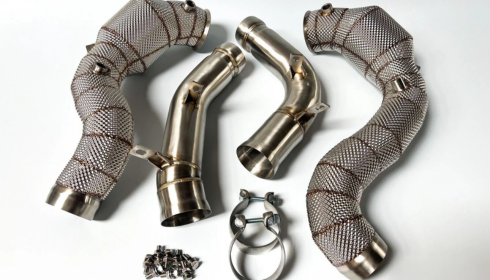Mercedes E63 Downpipe Install: A Complete Guide for Performance Enthusiasts

The Mercedes E63 Downpipe Install is one of the most popular upgrades among car enthusiasts who are passionate about enhancing their vehicle’s performance. The Mercedes E63 AMG is already a beast on the road, but a simple modification like installing a high-quality downpipe can unlock even more power, improve throttle response, and offer a more aggressive exhaust note. In this article, we will explore the step-by-step process of installing a downpipe on the Mercedes E63, the benefits of this upgrade, and what you should keep in mind before starting.
What is a Downpipe?
A downpipe is an essential part of the exhaust system that connects the turbocharger to the rest of the exhaust system. It plays a crucial role in expelling exhaust gases efficiently from the engine. The factory-installed downpipes usually come with catalytic converters that restrict the flow of gases, which can limit engine performance. Upgrading to an aftermarket downpipe reduces these restrictions and significantly boosts the vehicle’s performance.
Benefits of Installing a Downpipe on the Mercedes E63
There are multiple advantages to installing a downpipe on the Mercedes E63. Some of the key benefits include:
- Increased Horsepower and Torque: By allowing exhaust gases to exit the engine more quickly, the downpipe helps improve horsepower and torque.
- Better Throttle Response: Less back pressure means quicker turbo spool and improved throttle sensitivity.
- Aggressive Exhaust Sound: Many car enthusiasts love the deeper, sportier sound that comes after installing a downpipe.
- Potential for Higher Boost Levels: With reduced restrictions, the turbo can operate more efficiently at higher boost pressures.
Tools and Equipment Required
Before you start the installation, make sure you have the following tools and parts:
- Aftermarket downpipe (preferably stainless steel)
- Socket wrench set
- Penetrating oil
- Jack stands or hydraulic lift
- Oxygen sensor socket
- Gaskets and hardware provided with the downpipe kit
Step-by-Step Mercedes E63 Downpipe Install Process
1. Prepare the Vehicle
Start by parking your Mercedes E63 on a flat surface. Allow the engine to cool completely as working on a hot exhaust system can be dangerous. Use jack stands or a hydraulic lift to raise the car safely and ensure easy access to the underside.
2. Disconnect the Battery
Always disconnect the negative terminal of the battery to avoid any electrical issues or accidental shorts during the installation process.
3. Remove the Existing Downpipe
Locate the stock downpipe connected to the turbocharger. Spray penetrating oil on all bolts and fasteners to make the removal process smoother. Use the socket wrench to carefully unbolt the downpipe from the turbocharger and the mid-pipe.
4. Detach the Oxygen Sensors
The downpipe will have oxygen sensors attached. Use the oxygen sensor socket to carefully remove them without damaging the wiring. Remember to mark which sensor goes where to ensure correct reinstallation.
5. Install the New Downpipe
Position the new aftermarket downpipe and secure it to the turbocharger using the provided gaskets and bolts. Tighten the bolts to the manufacturer’s specifications. Reconnect the mid-pipe and ensure all connections are sealed properly to avoid exhaust leaks.
6. Reinstall Oxygen Sensors
Carefully reinstall the oxygen sensors in their correct positions. Ensure that the wiring is safely tucked away from any hot components.
7. Reconnect the Battery and Lower the Vehicle
Once everything is in place, reconnect the battery terminal. Lower the vehicle carefully from the jack stands or lift.
8. Test the Installation
Start the engine and check for any exhaust leaks or warning lights on the dashboard. Listen for the newly enhanced exhaust tone and ensure the car is running smoothly.
Final Thoughts
The Mercedes E63 downpipe install is a rewarding modification for those looking to boost their car’s power and performance. It’s an excellent way to enhance the driving experience, both in terms of sound and responsiveness. While the installation can be done at home by skilled DIY enthusiasts, professional installation is recommended if you are unfamiliar with exhaust systems to ensure safety and optimal performance.




